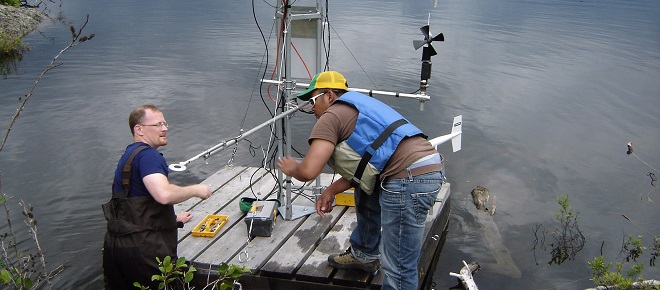How Budget 2012 is still making scientists anxious
Tease the day: The future of the renowned Experimental Lakes Area is still unknown
Scientists set-up a raft with one of a series of micro-meterological stations on a lake, in this undated photo. Scientific projects could die on the vine because of cuts to the federal Fisheries Department, university researchers say. THE CANADIAN PRESS/ho, Experimental Lakes Area
Share

Austerity breeds uncertainty. Finance Minister Jim Flaherty sparked anxiety aplenty when he tabled Budget 2012 in the House of Commons on March 29, 2012. That document set the stage for 19,200 job cuts across the federal public service. Many thousands of public servants received notices that their jobs might be cut, but maybe not. For many, that uncertainty was worse than a pink slip, and it led to ballooning mental health claims from weary workers. Knowing was better than not knowing.
This morning, The Globe and Mail reminds us of the uncertain fate of the Experimental Lakes Area research station, a group of dozens of lakes in northwestern Ontario that, for 40 years, scientists have used to study ecosystem stewardship, human impacts on watersheds, and global threats to the environment. Budget 2012 cut federal funding to the ELA, a savings of $2 million widely condemned by the scientific community. Eventually, the government announced its intention to transfer the facility’s operations to a third party. Last March, as the feds sought that third party, Fisheries and Oceans Canada began dismantling summer cabins used by researchers. In April, Ontario Premier Kathleen Wynne pledged undisclosed financial support to keep the research station operational. Then, in May, former fisheries minister Keith Ashfield found a willing partner and announced a memorandum of understanding with the International Institute for Sustainable Development.
The IISD launched talks with the province, which owns the land, on an agreement to operate the research station. The feds reopened the station as those negotiations continued—but only until Sept. 1. That brings us to today’s story in the Globe, which reports there’s still no deal, and time is running out. “The IISD needs to know the size of the Ontario commitment before it can develop a business plan and determine what kind of fundraising will be necessary to keep the facility afloat,” the paper says. If nothing gets sorted out, though, the ELA will close for, well, who knows how long?
In the meantime, scientists face the same uncertainty all those public servants faced for so many months, their anxiety just another by-product of an austerity budget more than a year old.
What’s above the fold this morning?
The Globe and Mail leads with the generational change represented by the royal baby and his parents. The National Post fronts the baby’s first public appearance. The Toronto Star goes above the fold with the Montreal, Maine & Atlantic Railway’s apparent failure to pay $4 million in clean-up costs in Lac-Mégantic, leaving the town and province to pay workers. The Ottawa Citizen leads with the Prince of Cambridge’s emergence into the outside world. iPolitics fronts the Liberal-Conservative battle for votes in Canada’s North. CBC.ca leads with the duchess of Cambridge’s challenge: be both a devoted parent and a committed member of the royal family. CTV News leads with the royal baby’s first public appearance. National Newswatch showcases a CBC News story featuring former Saskatchewan premier Roy Romanow, also the leader of a Royal Commission into healthcare’s future, urging Prime Minister Stephen Harper to talk to the provinces about healthcare funding.
Stories that will be (mostly) missed
| 1. Experimental Lakes. A research station in northwestern Ontario that was thought to be saved from closure earlier this year is running out of time before the feds once again lock its doors. | 2. Natural gas. An aboriginal group on B.C.’s coast that opposes the Northern Gateway pipeline hopes to become a partner in natural-gas projects that would allow it to buy back its traditional territory. |
| 3. Submarine. Two years after HMCS Corner Brook hit bottom off the west coast and sustained damage to its bow dome, the navy doesn’t know the total cost of repairs to the diesel sub. | 4. Taser. When Aron Firman died accidentally during an encounter with police in Collingwood in June 2010, the use of a Taser was an “aggravating factor,” according to a coroner’s jury. |
| 5. Iraq. The jailbreak in Iraq that freed hundreds of inmates and killed more than 50 people apparently received help from guards inside the prison, according to interior ministry officials. | 6. Myanmar. President Thein Sein released 73 political prisoners after an earlier pledge to release all of the government’s jailed opponents within months. About 130 such prisoners likely remain. |